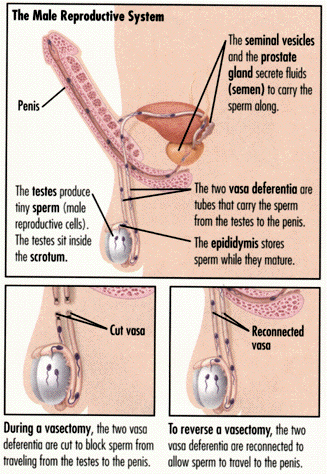





Surgical sterilization is a very effective way to achieve permanent infertility and has a failure rate of only 0.4%. In women, the process is often referred to as "tying the tubes," but in actuality the fallopian tubes may be tied, cut, clamped, or blocked. This serves to prevent sperm from joining the unfertilized egg.
Although sterilization may seem an
attractive alternative to reversible methods, as it dispenses
 with the need for forethought and planning before sex, it has
its own set of drawbacks. It is expensive, costing between $1,000
and $3,000. Sterilization requires exacting abdominal surgery
and anesthesia, both of which carry health risks. Surgical complications
include infection and uterine perforation.
The medical risks
multiply if a hysterectomy is performed for sterilization (as
opposed to simply treating the fallopian tubes); hysterectomy
should never be used for this purpose. Long term health risks
of sterilization include ectopic pregnancy, cervical cancer, menstrual
cycle disturbances (increased bleeding and pain), and gynecological
problems necessitating hysterectomy.
with the need for forethought and planning before sex, it has
its own set of drawbacks. It is expensive, costing between $1,000
and $3,000. Sterilization requires exacting abdominal surgery
and anesthesia, both of which carry health risks. Surgical complications
include infection and uterine perforation.
The medical risks
multiply if a hysterectomy is performed for sterilization (as
opposed to simply treating the fallopian tubes); hysterectomy
should never be used for this purpose. Long term health risks
of sterilization include ectopic pregnancy, cervical cancer, menstrual
cycle disturbances (increased bleeding and pain), and gynecological
problems necessitating hysterectomy.
Sterilization should be considered permanent. Women are sometimes pressured into getting sterilized by well-meaning medical professionals or social workers. Women are especially susceptible to this sort of pressure right after a trying pregnancy or abortion. Many are under the mistaken impression that sterilization is easily undone. One in three sterilized women regret their decision at some point in their lives, and many seek to have the procedure reversed. Reversals are very expensive -- costing $10,000 or more, and results are iffy. Common reasons women seek reversal are because of a change in marital status, the death of a child, or just because they want more children. For this reason, sterilization is not recommended unless you have a medical condition that would make pregnancy difficult or dangerous. Male sterilization, or vasectomy (below), is medically safer but should also be considered permanent.
MALE STERILIZATION
Vasectomy is a very effective way to achieve permanent infertility. It involves severing the vas, the tubes which deliver the sperm from the testes to the penis, through an incision in the scrotum. This procedure is usually performed in a doctor's office using local anesthetic and takes less than thirty minutes. Recovery may involve some pain or discomfort and scrotal discoloring for several days after the operation.
The operation is not effective immediately. It may take several months (15-20 ejaculations) before the sperm is cleared from the tubes. Some men may regret their decision to become sterilized, especially men under the age of 30, those who have no children, or those who later decide they would like more children after a remarriage or death of child. Vasectomy should be considered permanent. Reversals are difficult, expensive and results are not guaranteed. Although sperm can be found in the ejaculate of most men who have their vasectomies reversed, only 50% are successful at fathering children. A weak link between vasectomy and prostate cancer has been documented but not proven.
Vasectomy has a failure rate of only 0.1%. Unplanned pregnancies resulting after vasectomy is actually higher as the failure rate does not include couples who became pregnant as a result of intercourse after sterilization but before all sperm had been cleared from the ejaculate. This procedure can also fail due to surgical error, because the man had an extra set of vas (the tubes which transport the sperm), or even rarely spontaneous regeneration of the vas.


Go to next section
Visitors Since 9-5-97
Updated: August 7, 2001
